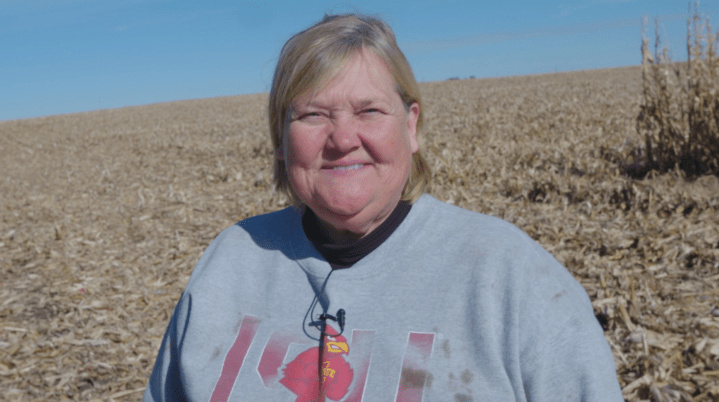
As prices at the grocery store rise, farmers’ costs are up too
As prices at the grocery store rise, farmers’ costs are up too

Just under a year ago, Iowa corn and soybean farmer April Hemmes said her crops were selling for double what they could a year prior. But, she predicted, “all that means is our inputs are going to go up next year.”
Now, the top concern for farmers is higher input costs, according to a report from the Purdue University Center for Commercial Agriculture. “Marketplace” host Kai Ryssdal spoke with Hemmes about the price increases she’s seeing at her farm. The following is an edited transcript of their conversation.
Kai Ryssdal: How are you?
April Hemmes: I’m freezing, but doing OK. Came from 80-degree weather yesterday to about 20 below windchill factor today.
Ryssdal: Where were you yesterday?
Hemmes: So, I got to go to Dubai [United Arab Emirates], and yeah, they had an oil and meal processors conference. So I told them how I sustainably raise soybeans on my farm and [it’s a] pretty good gig until you come home to snow and freezing weather.
Ryssdal: I was just gonna ask, you know, you’ve been globe-trotting, but how is it down on the farm? I mean how’s the farm business, as it were? Granted, it’s the middle of winter, but still.
Hemmes: Yes, it is the middle of winter. But right now, we prepay; I prepay everything. So right before I left, I paid for a bunch of my seed. And that price, surprisingly, hadn’t gone up as much. But nitrogen is a whole ‘nother story. All of our inputs, like everybody’s grocery store bills are higher — well, the farmers are the same way.
Ryssdal: Can you get everything you need? I mean, well, wait. So let’s back up. Why are prices higher? Is it just demand or what?
Hemmes: Well, I tell you what, I don’t know. I talked to my fertilizer and chemical guy. So I paid 32 cents a unit for my nitrogen a year ago. This year, I wrote the check, it was over 60 cents — so it doubled. And if I would have waited until this spring, when they apply it, it’s over $1 a unit now. And that’s just nitrogen for the corn. Last year, I paid around $20 a gallon for Roundup. And this year, it’s almost $75 a gallon.
Ryssdal: That’s insane. Do you recover any of that on the back end? I mean, does your price per bushel go up? Or no?
Hemmes: Well see, that’s just it. Our prices are dictated by like, if it’s grain, the Chicago Board of Trade. If you’re raising cattle or hogs, depends on if you have a contract with the packer or whatever. But we don’t get to say, ‘Hey, I need $6 a bushel for my corn in order to break even.” That’s not reality. So, you know, I hope none of the consumers out there listening are blaming the farmers for the high prices in the grocery store. Because, you know, we’re realizing the same thing.
Ryssdal: It’s got to be a supply chain thing, right? There’s got to be so much demand or there’s reduced supply, no?
Hemmes: Can I say the word “greed” in here? I don’t know. Pretty sure I may have suppliers a little upset with me, but there’s very few people that actually produce the nitrogen. So you know, they can kind of set the prices. And we are having troubles. My supplier can only guarantee me 80% of the Roundup or certain kinds of chemicals I can get. So, fortunately, you know, I will be making money if these prices stay up. But that’s a big if.
Ryssdal: What’s the word around the coffee shop? I mean, are your neighbors in the same boat? They must be. Are they changing anything?
Hemmes: Oh yeah, they’re all in the same boat. When I talked to my seed guys — as I lovingly call them — I said, “So, are farmers switching to planting more soybeans?” Because the fertilizer prices are mainly for corn. Soybeans don’t need a lot of inputs. And they said yeah, they are seeing more soybean sales. Which, for Iowa, is unheard of. We love to plant corn here.
Ryssdal: How long till you get to start putting seeds in the ground?
Hemmes: Beginning, middle of April. But we need moisture, we’re still dry. So hopefully things are all gonna be better by then, Kai. Can you work on that for me?
Ryssdal: I’ll do the very best I can for you.
There’s a lot happening in the world. Through it all, Marketplace is here for you.
You rely on Marketplace to break down the world’s events and tell you how it affects you in a fact-based, approachable way. We rely on your financial support to keep making that possible.
Your donation today powers the independent journalism that you rely on. For just $5/month, you can help sustain Marketplace so we can keep reporting on the things that matter to you.











